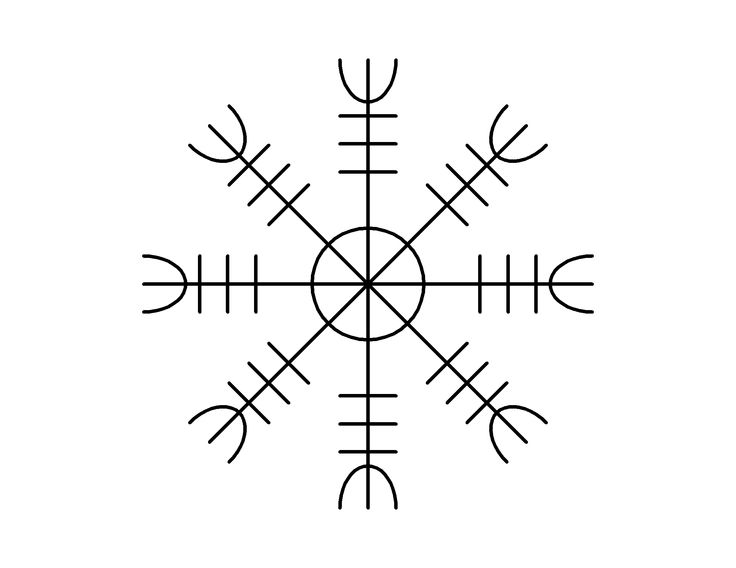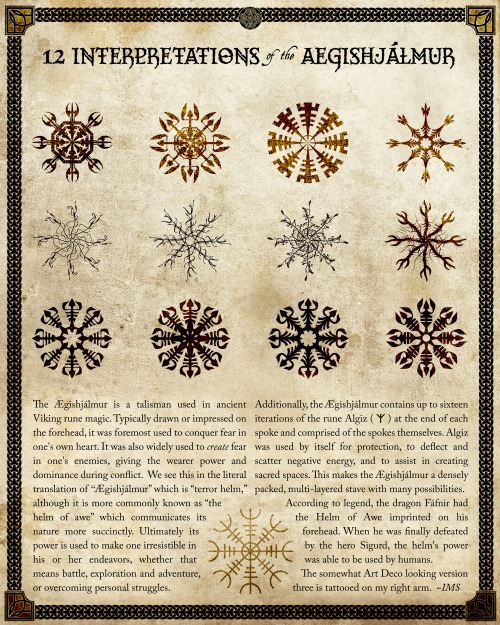The Helm of Awe (Old Norse Ægishjálmr, pronounced “EYE-gis-hiowlm-er”) is a powerful protective symbol used by the  Vikings (Northmen, Norse or Normans) for the purpose of protection from illness, and disease. In Norse mythology it is said that it is a symbol that was worn between the eyes that induces fear in your enemies, and to protect against the abuse of power.
Vikings (Northmen, Norse or Normans) for the purpose of protection from illness, and disease. In Norse mythology it is said that it is a symbol that was worn between the eyes that induces fear in your enemies, and to protect against the abuse of power.
The Norse word Ægishjálmr, is translated in English “helm of awe” or “helm of terror.” The meaning of the name awe is to strike with fear and reverence; to influence by fear, terror or respect; as, his majesty awed them into silence.
These enemies of the people, and this abuse of power I will attempt to prove are actually found in the worms that humans are born with, and die with. They are both the creator, and destroyer of man. In order for the Norse to maintain their health in such brutal dark and cold environments, they developed various health methods with charms, plants and medical regimes to strike awe and terror in these worms. In a sense, to protect them against the abuse of power of these same said worms with the help of charms such as the “helm of awe.”
 This will start to make sense to you once you understand the true medical history of the story behind The Helm of Awe. In many past articles I have written on history and health problems associated with the worm. In this, and future articles in relation to the Norse, I will detail much more evidence to support my medical theory that the Norse, just like many other cultures around the world, were essentially who we can call Northmen Gnostics and shamans who practiced medicine, healing, and encoded their teachings into mythology, charms and even their own ancient medical books. As with many cultures, their pagan religion, wisdom teachings, and medicinal rites were culture specific to the cold regions in which they inhabited, and the Norse priests or shaman who were both men and women were in charge of helping keep their people healthy.
This will start to make sense to you once you understand the true medical history of the story behind The Helm of Awe. In many past articles I have written on history and health problems associated with the worm. In this, and future articles in relation to the Norse, I will detail much more evidence to support my medical theory that the Norse, just like many other cultures around the world, were essentially who we can call Northmen Gnostics and shamans who practiced medicine, healing, and encoded their teachings into mythology, charms and even their own ancient medical books. As with many cultures, their pagan religion, wisdom teachings, and medicinal rites were culture specific to the cold regions in which they inhabited, and the Norse priests or shaman who were both men and women were in charge of helping keep their people healthy.
The Helm of Awe is mentioned mythologically in Norse poems such as the Poetic Edda. The poem called Fáfnismál tells of the havoc-wreaking dragon Fafnir whose powers come from the symbol of the Helm of Awe:
The Helm of Awe
I wore before the sons of men
In defense of my treasure;
Amongst all, I alone was strong,
I thought to myself,
For I found no power a match for my own.
In some of my previous articles on the ancient mythology of the serpent and dragon, I explained how the serpent and dragon were allegorical or esoteric representations of the worms that inhabit the human body. The Old English wyrm and Old Norse ormr, is where we get the English word worm, and they all mean dragon. The God Woden or Wodan in the Old English Nine Herbs Charm, is said to have taken nine “glory-twigs” and struck and killed a snake, AKA worm that personifies disease.(1) These mythological stories of epic battles of heroes such as Woden fighting and killing dragons, are in fact esoteric stories of powerful people who battle and kill the worm.
Sometimes you will find them as evil demons or devils, such as in Christianity that wreaked havoc on anyone who would become taken over by these worms. The fact that they were worms was often encoded by initiates into mythology in the form of a dragon, or some type of sea monster. After all, these are just ancient myths and stories. As of this date, the bones of a dragon or sea monster have never been discovered. But modern science, just like ancient science has already determined without a scientific doubt that there are 8 different kinds of worms who live, feed and die in the human flesh, bones and blood.
The oldest depiction of The Helm of Awe can be found in the Norse Medical Manuscripts known as the AM 434a in the  Arnamagnæan Institute at the University of Copenhagen. It is dated at around the 1500 century. The AM 434a is 49 pages long and begins with a series of charms, spells, and prayers. The charms listed give a brief set of health prognosis, a long list of illnesses with cures given for each one, and a monthly regime to maintain one’s health. One of these charms listed in The Helm of Awe (Ægishjálmr).(1)
Arnamagnæan Institute at the University of Copenhagen. It is dated at around the 1500 century. The AM 434a is 49 pages long and begins with a series of charms, spells, and prayers. The charms listed give a brief set of health prognosis, a long list of illnesses with cures given for each one, and a monthly regime to maintain one’s health. One of these charms listed in The Helm of Awe (Ægishjálmr).(1)
Today, the helm of Awe is used as a charm of protection and an emblem of identification by the followers of Asatru. This is a perfect symbol for Asatru because it is truly an ancient symbol of the Norse to help protect them from sickness and disease.
In future articles, and in respect to the Norse culture, I will detail more of these ancient medical teachings, charms and mythology to help connect them to their past.
DISCLAIMER:
My name is Maurice “Moe” Bedard, and I’m of both Phoenician and Norse descent. When I first saw the symbol of the Helm of Awe, I immediately felt an incredible intuitive feeling that I knew what the symbol was, and had to write about it even though I wasn’t educated on the history of this symbol or its true meaning.
My ancestor Father of English History and Doctor of the Church, Saint Beda (Bede) is actually mentioned as a source in the Norse Medical Manuscripts known as the AM 434a that mentions the Helm of Awe. Hence, I believe I’m connected to the Norse through my ancestry, and the fact that Beda had contributed to the Norse Medical Manuscripts.
SOURCES:
1. The Troth Norse Magical and Herbal Healing By Ben-Waggoner

Moe is the founder of GnosticWarrior.com. He is a father, husband, author, martial arts black belt, and an expert in Gnosticism, the occult, and esotericism.

to treat against worms in body my ancestors used a plant called ramsløk and drank tea of it. it can also be used to chew beside other food. very strong garlic taste.
Lbs. 143 8vo is dated 1670. The version shown is just one of many. I’ve been studying specifically Galdrastafir for over two years and never has any stave indicated the treatment of worms.